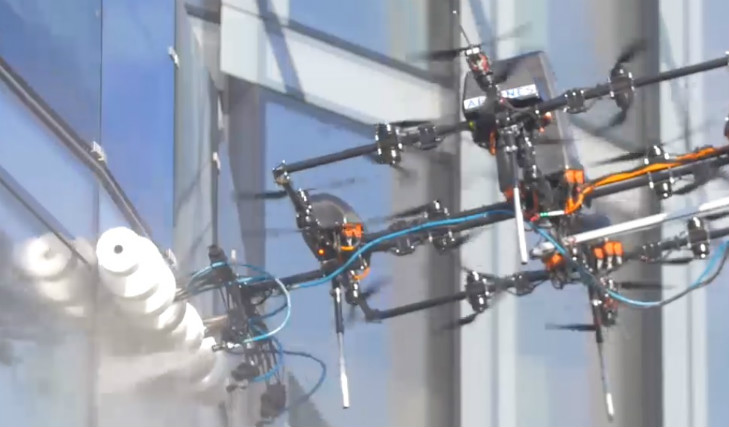
Drones have become a mainstay in many industries because of their capacity to save time, cut costs, and reduce risks.
Indeed, they have made their way into all sorts of industries: search and rescue, agriculture, military, advertisement, real estate, and…cleaning?
A drone company, Aerones, based in Latvia, has built an enormous washing drone that looks set to revolutionize the way we clean windows forever. The machine was built purposefully to replace the human operated cradles which you’ve seen dangling on the side of huge skyscrapers and towers.

Aerones first gained fame in 2017, when they hit the headlines for using one of their remote controlled helicopters to carry out a rescue mission. Today, they claim their window-washing drone can work 20 times faster than human powered methods and is also much safer.
So how does this window-washing wonder work?
It is 3 meters wide and flies with twelve rotors. It is equipped with hoses, sponges, and on-board cameras to help the operator on the ground have a clear idea of all that is going on during the washing process.
The drone is powered from the ground. A battery on the ground powers the machine through a cable linking the two. Water is also fed to the machine from the ground through a hose that connects to a tank on the ground.
With the current design, this window-washing drone can rise as high as 350 meters into the air, but there is no reason to believe this height will not be increased given time and resources.
The manufacturers have also created a unique stabilization system that will allow the drone work in blustery conditions. This will make the drone more likely to be available for deployment at any given time, irrespective of the prevailing conditions.
But what if there was an error? Would everything come crashing to the ground?
There is always a risk of drones malfunctioning — or any other aircraft for that matter.
To avoid the risk of this drone falling on anyone’s head, however, it is secured by a safety cable that is attached to the top of the building it is cleaning. A similar setup exists for human cleaners where their baskets are secured to the top of the building to ensure safety.
Like a rock climber, the drone is secured should it fall.
This window-washing drone made in Latvia has all the markings of a machine made to win. However, one can only wonder at how effective it actually is when in action.
Aerones have made a video available that shows the drone in action.
While it clearly works as it is supposed to, one cannot know for sure how effective it is at cleaning windows merely by watching a video on the internet.
For example, how effective will this drone be against those notoriously difficult splotches that birds are generous enough to gift us every so often?
Will such stubborn stains require a do over, but this time by some human agents doing it the old fashioned way?
Window-Washer or Firefigher?
If you take one look at the video that shows the Aereones’ window-washing drone in action, you may find yourself wondering how effective those high powered water hoses could be against fires.
Or, you may not, but someone else certainly has been.
Aereones has already thought of that — a variant of the drone is already in the advanced stages of development for firefighting purposes.
The firefighter version of the drone will work in a similar way to its window-washing cousin, and will receive power and water from the ground.
A third version is already completed that is specifically aimed at inspecting and cleaning wind turbines.
You can expect more versions to come forth to meet other needs that drones meet better than humans can.
Could a Regular Drone be Adapted to Wash Windows?
Whilst we love drones here at Dronesvilla, we’re certainly not engineers. So don’t take everything we say at face value when it comes to what can and can’t be done with a bit of ingenuinity.
However, we’d say it’s pretty unlikely that a regular recreational drone could be used to wash windows.
The main reason for this would be the issue with carrying a payload. Some recreational drones are able to carry a payload of around 5kg, but this would almost certainly be outmuscled by the weight of a long hose filled with water. Water is surprisingly heavy — one litre (1L) weighs almost exactly 1kg.
And this just covers water. What about soap? What about wiping the windows down afterwards? Window cleaners don’t just use water, they use a variety of instruments to get your glass squeaky clean.
With all of this in mind, we’d say that no, you can’t use a regular drone to clean your windows.
But as we saw above, there are definitely possibilities for this in the future, so watch this space.

can your company make drones for putting out fires at high rise buildings that firefighters cant reach?
I’m sure there are companies out there that could make this, but we’re just a blog!
I would like to see possibility in having this in Dubai
Logrará más adelante poder pintar paredes a gran altura estamos a un 10% de lo que en un futuro podrá desarrollar el famoso hoy Drone
Later you will be able to paint walls at high heights, we are at 10% of what in the future the famous Drone will be able to develop today.